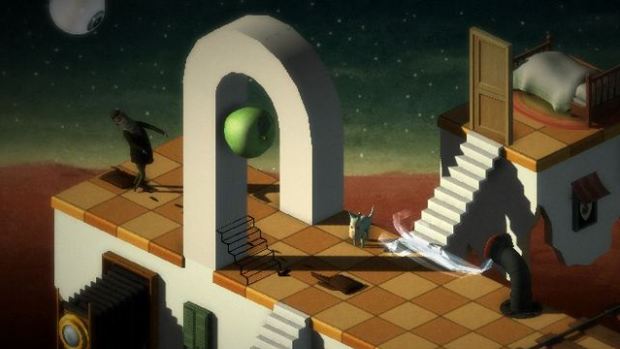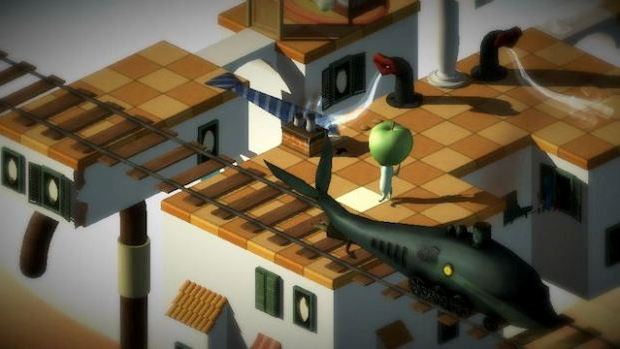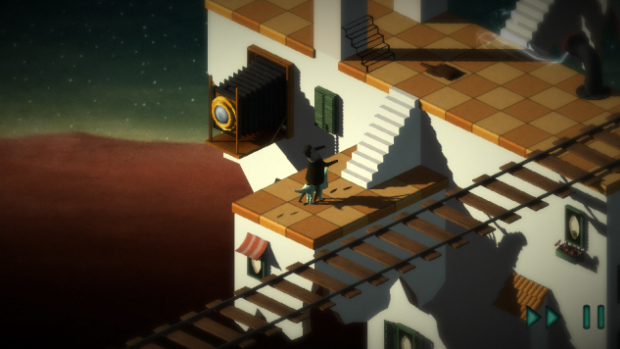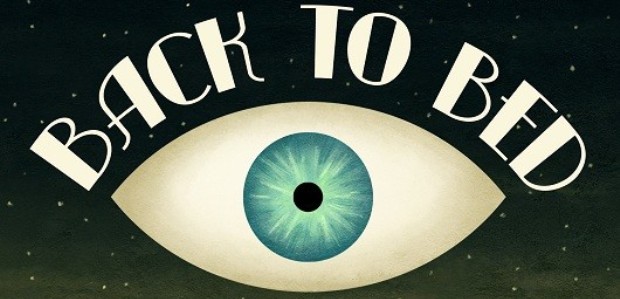When you sleep, what do you dream about? Promotions at work? Falling into a pit of snakes? All night dance parties hosted by Richard o’Brian striking constant Haddaway poses, playing a mash up of “What is Love” and “Sweet Transvestite” from The Rocky Horror Picture Show? Well, no matter what you do dream about, your snooze visions aren’t half as strange as Bob’s…
Back to Bed is a tale of Bob, a chap with a bad case of narcolepsy. Thing is, Bob’s sleep thoughts are fever dreams that mesh the artistic visions of M.C.Escher, Salvidore Dahli, Monty Python and the omnipresent eye of 1984. It’s within these tapestries of melting clocks, finger bridges and perception testing walkways that you play a dog-like creature with Bob’s own visage, uses apples and fish, amongst other things, to ensure that Bob safely navigates his mind messes and gets back to bed. Oh, and at one point there’s a whale train. That’s a train that is a whale. Yup.

Outlandish presentation aside, Back to Bed is a puzzle game. Bob has a spot of the Zoolanders in that he can only turn one way, and bumping into something causes him to turn. You scamper around as the Bob Dog picking up the various objects that litter a given stage, dropping them in Bob’s way to shepherd him to each level’s exit.
The basic task in itself isn’t too tricky, but the optical illusions present in a level construction can often contribute to many necessary mental leaps. Obstacles and additional traversal considerations are introduced as you go, but the main levels aren’t actually too tricky, and it’s more the confusion caused by the illusionary art style that tends to hide the solution to each individual mind bender, and this can actually be as frustrating a revelation as it is satisfying, which isn’t great.
That’s not to dismiss Back to Bed. It’s certainly an entertaining concept and its Nightmare levels are a genuine challenge, but it’s never as smart as it thinks it is. A puzzle game’s quality lies in the oomph of the eureka, and Back to Bed’s moments of realisation chime in at a low hum, a polite “Ah, yeah, I’ve got to do that”, rather than a bombastic “That’s it!”

Perhaps it’s due to the direct control of Bob Dog that this is the case, as it becomes more about the doing than the working out, about squirreling your way around Bob to make sure that the obstacles are where they need to be when they need to be it. It’s less about pre-planning and more about fudging your way through until Bob’s in bed.
The very lax punishment for having Bob fall off an edge – and by lax, I mean none – doesn’t imbue the puzzler with as much satisfaction as it might were failure more frowned upon, or the levels somewhat longer. Enemies do engage a restart, but then the levels are still tiny. It makes Back to Bed entirely pleasant to play, but it undermines the satisfaction of the puzzle solving nonetheless.
Perhaps the reason you’d play Back to Bed is more to do with its rather stunning presentation. It’s a gorgeous game to look at, undoubtedly, putting forward a brave collection of styles with surprising cohesion; Back to Bed is an absolutely mesmerising game. Add to that the hypnotic background music and on-message drowsy narrator, together with a whimsy tinged narrative, and you’ve got a game that’s more than worth the hour or so it will take to see just to, well, see it.

Again it’s not a bad puzzle game, just a wholly underwhelming one. The use of optical illusions serves more to create arbitrary confusion and are never integrated in as interesting a way as, say, Echochrome (a game in which manipulating the optical illusion was the entire point), but Back to Bed is still an amusing diversion that’s a stunner to just be in.
VERDICT: Back to Bed is an acceptable puzzle game with outstanding presentation. The gameplay simply leans too heavily on illusions to offer a top tier puzzle experience, but it’s worth investigating simply for the dreamy combination of M.C.Escher, Salvidore Dahli and Monty Python. It puts my Rocky Horror styled nightmares to shame with ease, and is an artistic vision that will stick with you for a long while after you’ve cleared its short campaign.

DECENT. A 6/10 indicates that, while this game could be much better, it still has a fair amount to offer the player. It might be an interesting title sabotaged by its own ambition, or a game denied greater praise by some questionable design choices. Don’t avoid it outright, but approach it with caution.
Review code provided by publisher.






